This was published 8 years ago
Paris: Tips on how to plan your trip to the Louvre (and beat the tourists)
By Luke Slattery
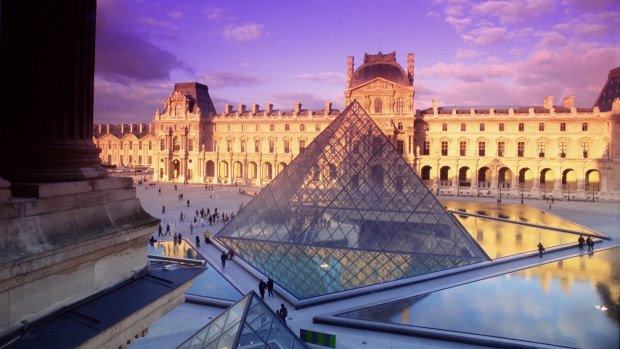
Try a lesser known entrance to the art gallery, to avoid the crowds.Credit: Getty Images
There are three compulsory stops on any tour of Paris: the Eiffel Tower, Cathedral of Notre Dame, and the Palais du Louvre. But only the latter, in my view, repays multiple visits.
In fact, there is really no excuse for failing to revisit the Louvre each time you return to Paris. With almost 35,000 objects ranging from an Egyptian dice no bigger than a knuckle to Veronese's supersized 10-metre-long Wedding Feast at Cana, the museum's collection is as varied as it is vast.
There was a time, during a six-month stay in Paris, when I wandered through the Louvre's majestic galleries once, and often twice, a week. The only other Parisian institution I frequented at this rate was a wine bar called la Belle Hortense, but I can't honestly say that the time there was well spent.
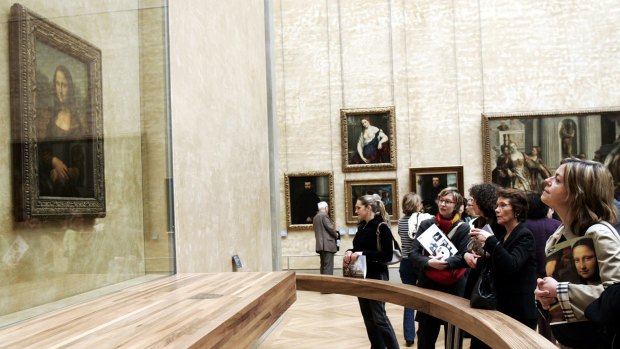
If you start with Leonardo Da Vinci's Mona Lisa, you'll get there early enough to see it through the smartphones.Credit: AP
The Louvre, on the other hand, was always uplifting. Always edifying. The contemplation of some five millennia of human artistry invariably helps to put daily life into a broader perspective; and what is wisdom if not that.
Concerned about superannuation? Dwell on the immortal-mortality of the sarcophagus of Iniuia from the Egyptian 19th dynasty. Confused about sexuality? Be challenged by the sleeping hermaphrodite by an unknown Roman sculpture working from a lost Greek original.
The Louvre is full of old dead stuff, and yet it's marvellously about life. On a recent return trip to Paris – my first in a decade – I felt the urge to get to grips with it all over again.
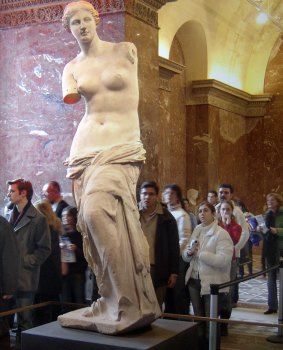
The Venus de Milo's robe seems to be sliding south.Credit: Wikimedia
On my first morning in the city, I make my way to the Louvre at its 9am opening time. One consequence of increased security in the wake of the November terrorist attacks is that the entrance I'd once regarded as a sneaky secret, the Lion Gate on the Seine side, is closed.
It's worth trying this entrance when it reopens to the public, as it surely will. Not only are the queues barely existent, but it sits directly below the Grand Gallery of the Denon Wing, the world's richest stretch of high art real estate.
The other wings of the Palais du Louvre, Sully and Richelieu, are all connected to Denon in a warren-like fashion. The problem is navigating one's way around the institution's 60,000 metres of floor space wrapped around several enormous courtyards. You need a plan. In fact two plans: a map of the institution, and an idea of how to approach it.
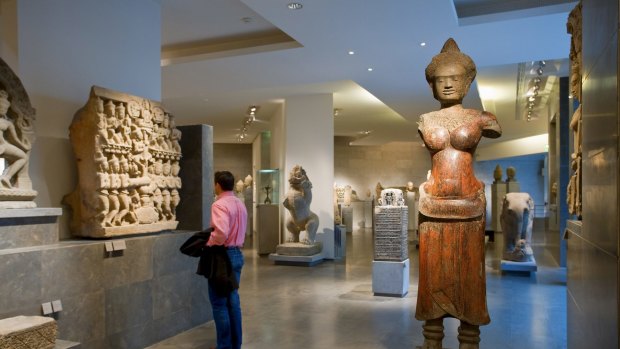
Get lost and you may discover a civilisation you've never heard of.
Fans of French second empire furniture, or aficionados of Phoenician antiquity (I've actually met one of their kind on a visit to Sicily) need read no further: you'll doubtless have your own specialised itineraries. For the remaining 99.9 per cent of the population, the Louvre experience will be a bewildering one if it's not honed to a manageable essence. Think of it, then, as an encounter with four women.
The first is a small portrait of a woman with a greenish pallor who looks to be putting on a brave face despite her suffering. Leonardo da Vinci's La Giaconda, best known by her English moniker, the Mona Lisa, is the world's most famous painting. I find it singularly unmoving, but can't deny its pulling power. Or its art-historical importance.
The second woman on the list, equally enigmatic, is the Venus de Milo; a sensuously modelled Hellenistic statue of the Greek love goddess Aphrodite (she was Venus to the Romans) wearing nothing but a robe that seems to be sliding south.
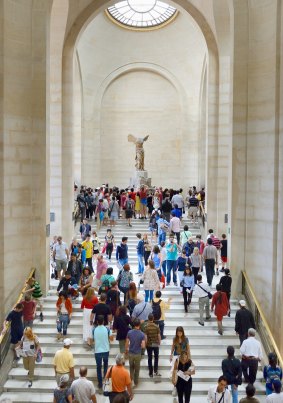
The Winged Victory of Samothrace, also called the Nike of Samothrace, is a 2nd-century BC marble sculpture of the Greek goddess Nike (Victory). Since 1884, it has been on display at the Louvre.Credit: Getty Images
Next comes Rembrandt's Bathsheba at her Bath, an affecting portrait of a woman about to lose one husband and gain another; and last is the dramatic Winged Victory of Samothrace, depicted in the pose of a Superwoman descending from the skies.
A smart organising principle of any trip to the Louvre is to get to these four beauties – only one of them fully clothed – with enough contemplative time for each. Of course, you could toddle around with a map in hand and a vague sense of what to look for, but I prefer the strategic strike while the eyes are still fresh and the crowds relatively thin. It's the Navy Seal approach to cultural appreciation.
So, enter the Denon wing and head for the Nike (Victory) of Samothrace, freshly cleaned and powerfully vital, atop the Daru staircase. After a decent amount of time in her powerful winged presence take a right, then another, to begin the long walk down the Grand Gallery of Italian art from the 13th to 17th centuries.
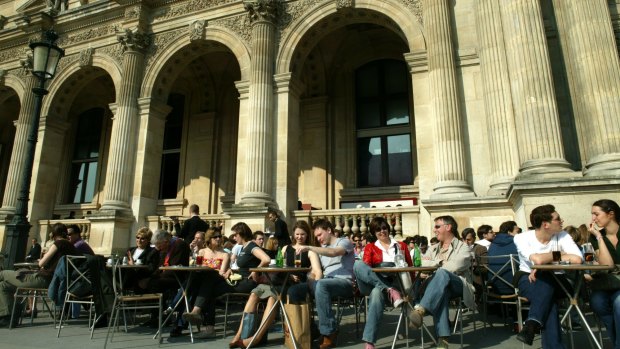
When your feet are sore and tired, get a coffee at one of the cafes nearby.Credit: Michele Mossop
It helps, at this point, to be purposeful: try not to linger beside the beguiling treasures on either side. You are headed towards Room 6, looming on your right, and an appointment with the Mona Lisa. There she is – smaller than expected – along with her admirers, an ocean of smartphones with people attached to them.
Her inscrutability and emotional distance – one of the secrets of her charm – is surely accented by the glass security panel that stands between you and her.
Now retrace your steps, stopping to view a cluster of Leonardo's lesser-known works, including the luminous Virgin and Child with Saint Anne. This canvas, in which the virgin, her mother Anne and the infant Jesus are seemingly tangled in a game of Twister, has been recently cleaned and scrubs up beautifully: allow yourself to be drawn to the magnificent crystal-blue chain of glaciers behind the trio and, at the point where the women's feet with their extraordinarily long toes touch the ground, the pebbly surface that literally earths this strange tableau.
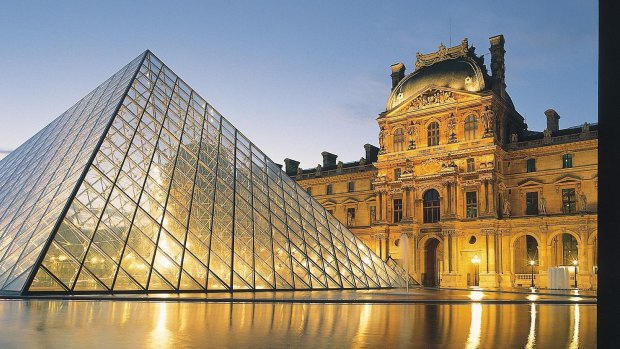
The Louvre is dominated by I. M. Pei's glass pyramid.
Returning to the Winged Nike, it's time for a deep breath. Take up a position in front of the statue before pivoting from the Denon wing, on the right, to Sully straight ahead.
Down on Sully's 1st floor lies a collection of marmoreal white gods and goddesses, most famously the Venus de Milo. The jaw of the love goddess is a little heavy. Her hips are a little wide. But there's no doubting her serene beauty: she is a love goddess still.
It would help to know what her missing arms were up to. Some say that in her left hand she held an apple, aka the Apple of Discord. It was her prize for winning the beauty contest – the other contestants were Hera and Athena – that triggered the Trojan War.
The last of the four beauties requires a nifty manoeuvre. The best route is to exit Sully and walk into the great fulcrum beneath I.M. Pei's glass pyramid. Time now to enter the last of the Louvre's three wings: Richelieu. Ask the ticket control at the entrance to Richelieu for the nearest lift – it's on your right – and step out at the second floor having left a whole lot of French stuff best left to ecoliers in your slipstream.
You stand now directly opposite the Grand Gallery, separated by a courtyard, but you may not realise it; in fact, you don't really know where you are!
The collection in this section of the Louvre, representing Germany and the Low Countries, is perhaps not the procession of hits offered by the Grand Gallery. There's only Bruegel – inexplicable! And one entire room dedicated to the abundant glossy flesh of Rubens is almost off-putting.
But when you come to the Rembrandt room, and take a seat before Bathsheba, you know you have entered a world of painterly poetry: of gravity, pathos and frailty, of vibrant shadows and burning browns. But that's Rembrandt; the Shakespeare of the plastic arts.
So there you have it, the four goddesses of the Louvre in perhaps an hour with an added 15 minutes of walking time. How to spend the rest of your two hours before the onset of museum vertigo, typically at the end of the third hour?
My suggestion is a recuperative coffee: there are several options within the Louvre ranging from the cheap and cheerful to the chic. Now is the time to stare at the middle distance, the table – anything but art.
Suitably refreshed you return to the Grand Gallery with eyes for the lovely Raphael portrait of Madonna and Child with John the Baptist and another Raphael – this one showing the artist and his age's secular side – of Baldassare Castiglione. Castiglione was the author of a book on the art of the courtier and he is shown here in hipster beard.
Three Caravaggios await you, as well as a scatter of Titian portraits. A number of these, including the Concert Champetre once attributed to Giorgione, lie obscured on the wall behind the Mona Lisa. This seems completely naff. But that's the Louvre. With so many riches, it can afford the odd embarrassment.
Having paid homage to the four goddesses of the Louvre – and hopefully enjoyed them before the crowd begins to swell – it's time for the Louvre's very own fragment of the Parthenon's Doric frieze: a centaur abducting a woman.
In the same niche is the Plaque of the Ergastines – weavers of a garment for the presiding goddess, Athena. It once adorned the east side of the Parthenon colonnade. Though not as comprehensive as the British Museum's Elgin group, this is a beautiful fragment from one of the greatest, and one of the first, works of Western art. The dignity, the solemnity – and ultimately the mystery – of these processional figures is intensely moving. Here is classical Athens at her finest.
The Louvre also boasts a comprehensive collection of Egyptian antiquities conveying a powerful sense of Pharaonic grandeur – what could be grander than the colossal statue of Ramesses 11? – and everyday life along the Nile delta.
The Near Eastern antiquities, such as the Code of Hammurabi and the Frieze of Archers, are equally magnificent. One thing is certain: if you try to do everything, you'll do justice to nothing.
Although this recent visit was perhaps my 30th to the Louvre, I still managed to take a wrong turn. I got lost, ended up on the ground floor, and discovered entire civilisations I never knew existed.
In no time at all, I felt like a fly trapped in a bottle, buzzing in circles, gasping for air. So keep it simple: do the four goddesses, take a coffee break, and then return for a second round with the Italian masters. Make a date with the Parthenon marbles. Follow it with a touch of the pre-classical world (Egypt or Mesopotamia) before the onset of museum fatigue, cultural vertigo – and very sore feet.
Outside on the streets of Paris, the restaurants and wine bars will come and go, though not in this city with the rapidity that they do elsewhere. The sarcophagus of Iniuia, on the other hand, is going nowhere. You'll be back.
See also: The coolest museums in the world right now
See also: 32 great reasons to visit Paris
TRIP NOTES
MORE INFORMATION
GETTING THERE
Singapore Airlines flies from most capitals to Singapore, connecting to Paris on its A380 service.
STAYING THERE
The Timhotel Palais Royal, about 700 metres from the Louvre and a mere 100 metres from the elegant Palais Royale gardens, must be one of the last genuine bargains in the heart of Paris. Basic yet clean doubles with free Wi-Fi from about $140. Request a courtyard room; see www.timhotel.com.
TOURING THERE
Entrance to the Louvre is $22.50; a two-day Paris museum pass offering entry to the permanent collections of around 60 of the city's museums costs $70.
DINING THERE
There are plenty of neighbourhood French bistros nearby, as is the city's Little Tokyo (be prepared to queue) along Rue St Anne.
Luke Slattery was a guest of Singapore Airlines.
Sign up for the Traveller Deals newsletter
Get exclusive travel deals delivered straight to your inbox. Sign up now.